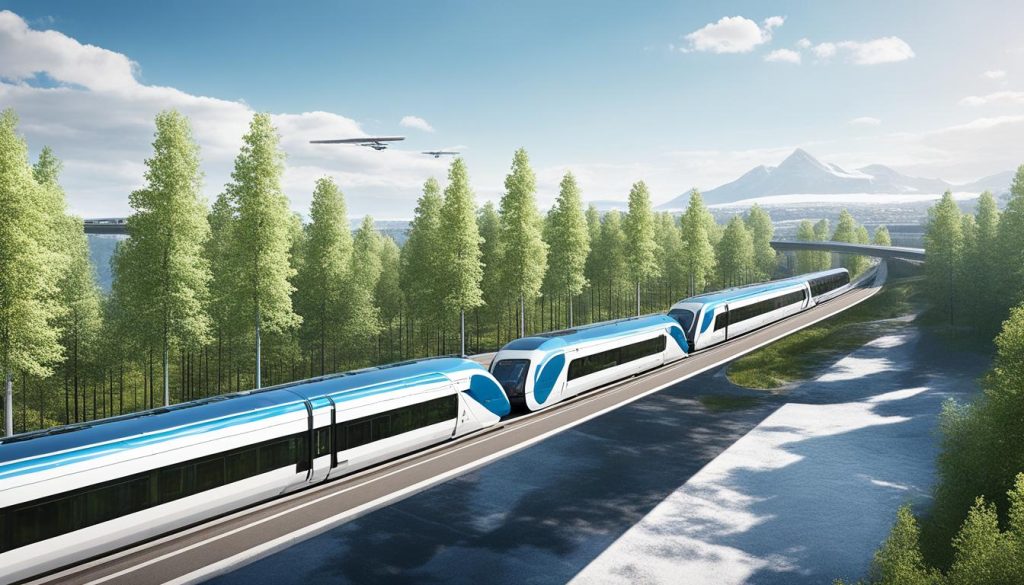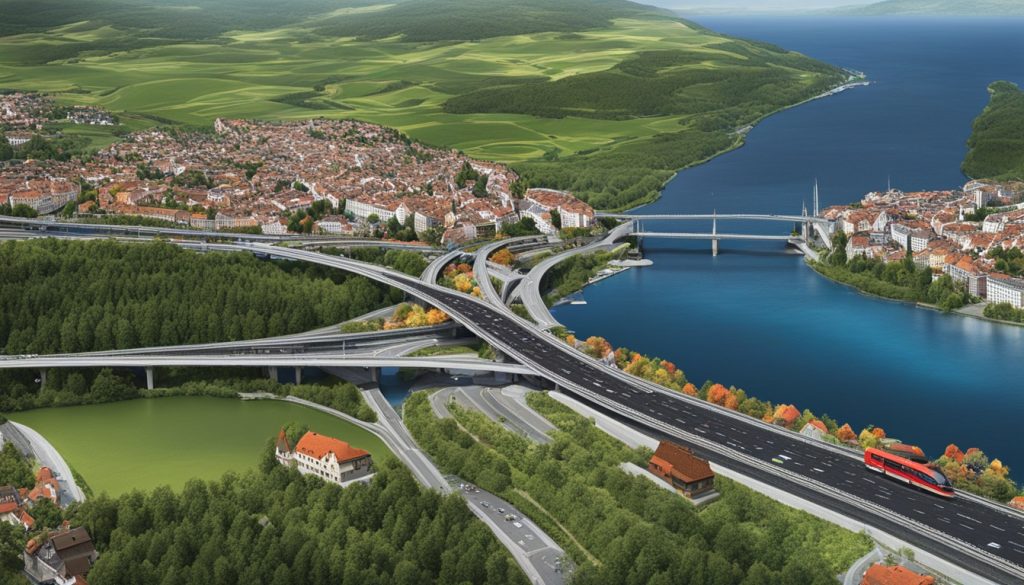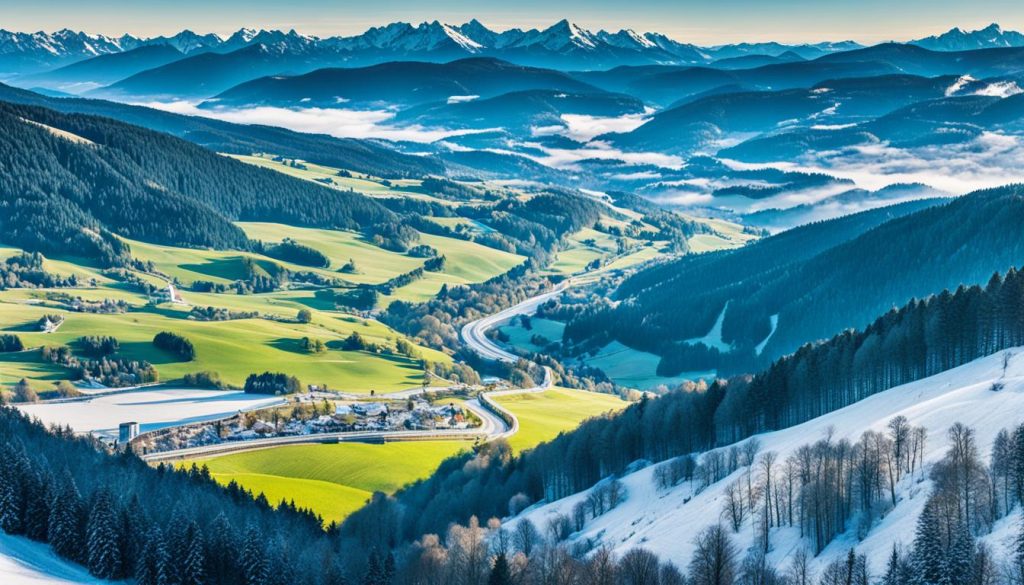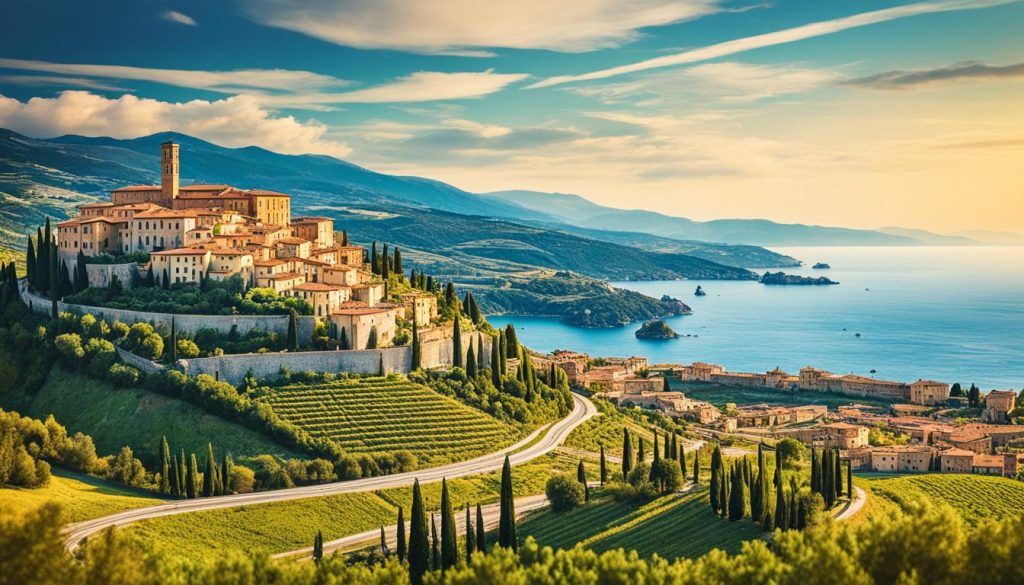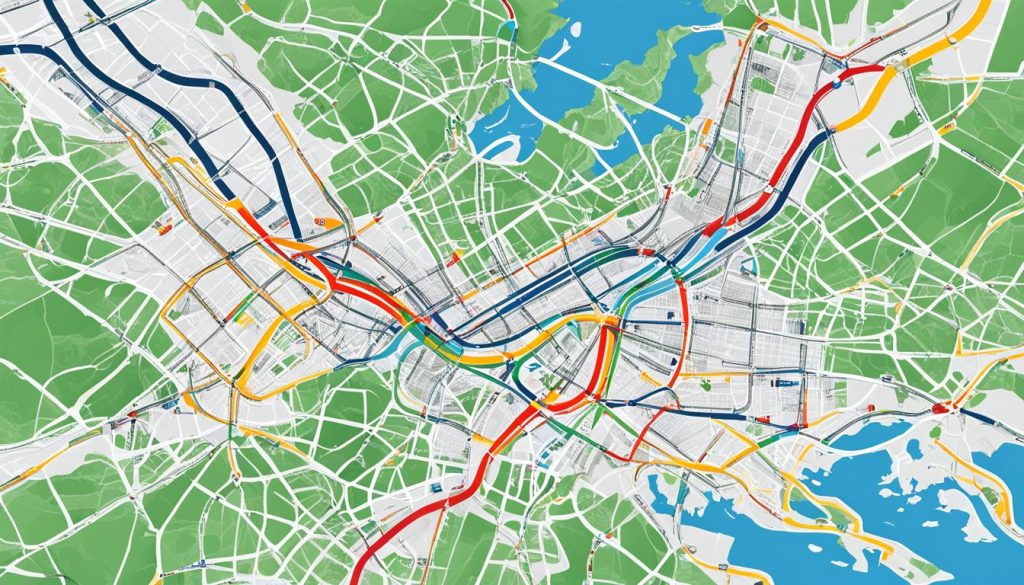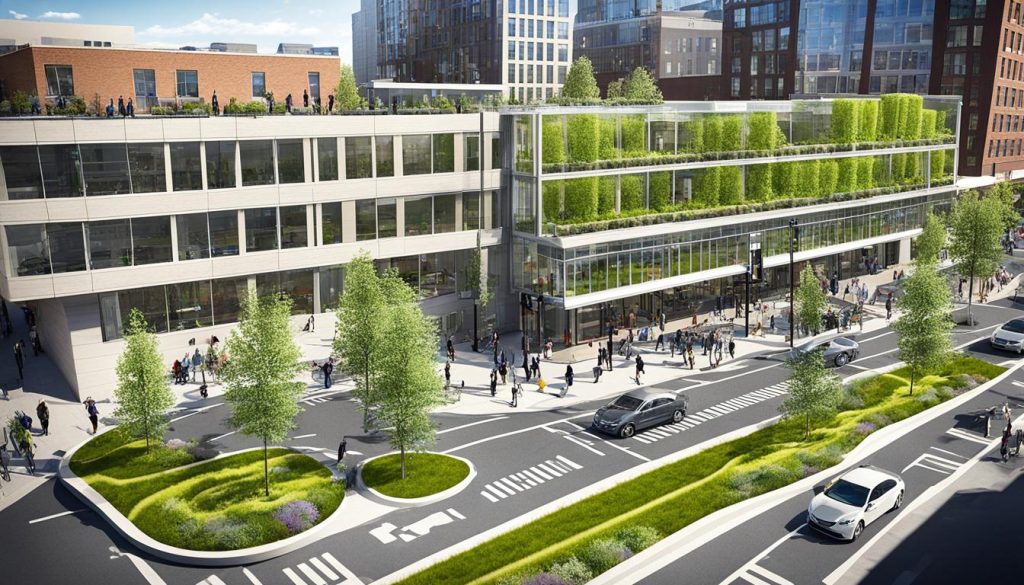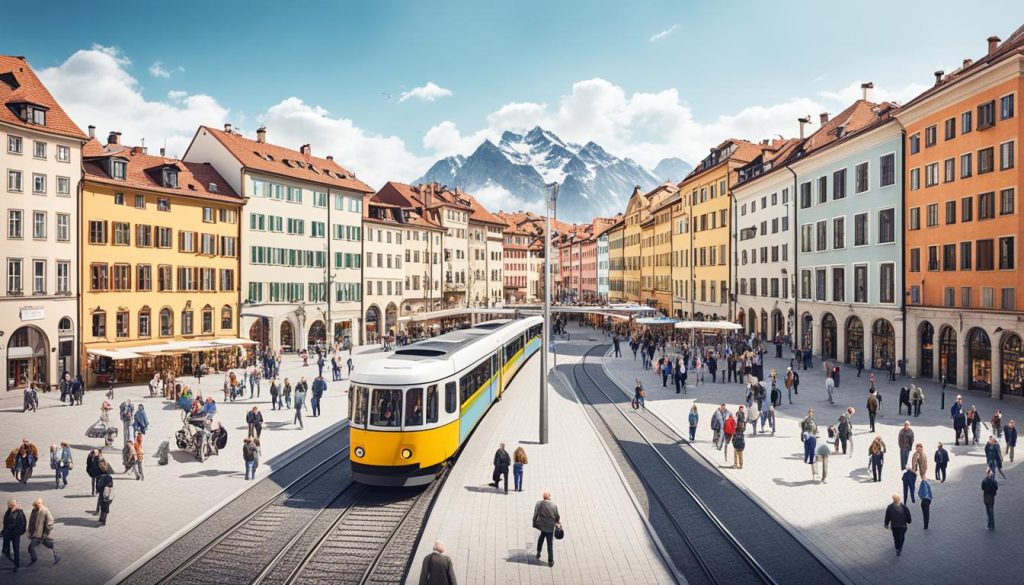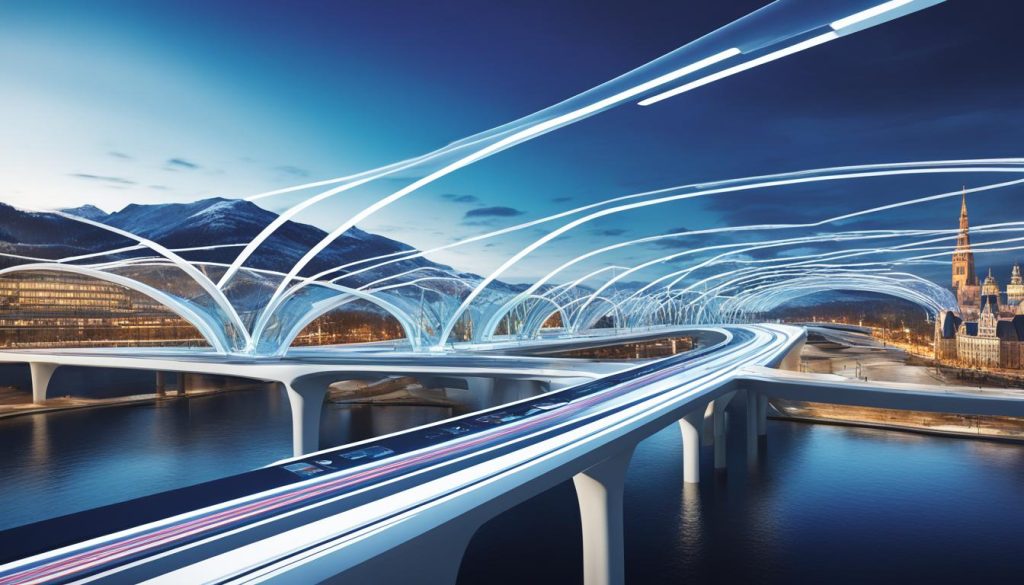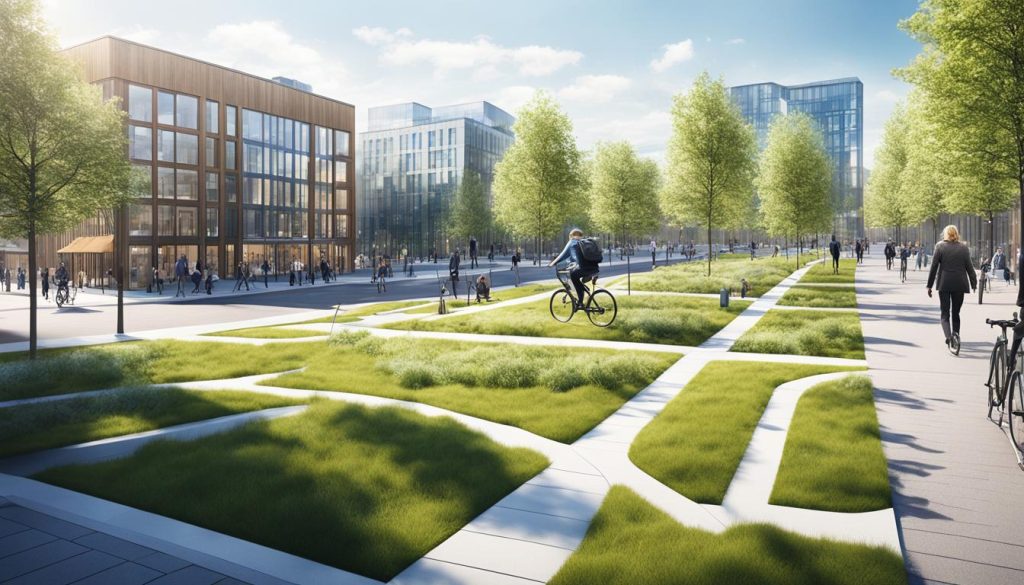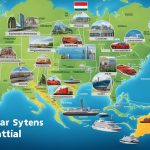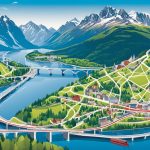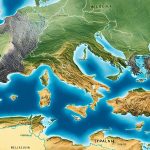Europe is a continent of stunning diversity, with the Nordic Snowy landscapes, Germany’s infrastructure prowess, and Italy’s hilly areas. Each place shows a different side of Europe. Grasping how infrastructure spending matches economic growth is crucial for understanding regional growth tactics.
The comparison between their infrastructures is fascinating. It shows how geography uniquely shapes each region’s infrastructure investments and their impact on society. From Scandinavia’s strong ports, Germany’s wide autobahns, to Italy’s engineering marvels in the Alps, each region adapts and innovates based on its terrain.
In facing modern challenges like climate change and new technologies, studying how these places invest in infrastructure is key. It tells us not only about their current state but also hints at their future readiness and success.
Introduction to European Geographical Variance
The European regions boast a wide range of landscapes, each with its own beauty and complexity. They are known as Eastern, Southern, Western, and Northern Europe, with the British Isles sometimes added on. These divisions have shaped not just the map, but also the culture and identity of the continent.
Over time, the lines between these regions have started to blend, thanks to the European Union. This unity is changing old boundaries, leading to a unified way of managing government, culture, and industrialised economies.
- The melting pot of Southern Europe, is a smorgasbord of history and sun-washed terrains, has moulded its culture and identity around its Mediterranean heartbeat.
- Northern Europe, known for its stark beauty and innovation-driven economies, stands as a testament to how geographical challenges can be transformed into econonomic strengths.
- Eastern Europe, with its complex history and transformative economies, continues to build its identity amidst changing political climates.
- Western Europe’s industrial prowess and cosmopolitan ethos exemplify a region that has long been at the crossroads of progressive change.
The coming together of European regions, despite their differences, builds the continent’s strength. The deep cultural identity has met the modern world’s demand for industrialised economies. This mix makes Europe both varied and harmonious.
An Overview of Nordic Geography
Our journey through Europe’s north unveils the unique essence of the Nordic area. It’s a place where tough geography meets strong infrastructure, under the Nordic sky. This area, known for its beautiful Scandinavian landscapes, is shaped by nature. It faces challenges but also offers chances for creativity.
Topographic Highlights of the Nordic Region
The peace of the Nordic lands is vast and striking. Their Viking past makes Iceland, Finland, Norway, Sweden, and Denmark stand out. With fjords, boreal forests, and archipelagos, the land shows nature’s skill in Scandinavia.
- The long coastlines support sea activities, leading to key ports for trade.
- The Scandinavian Mountains are a natural barrier, offering beautiful views.
- Expanses of taiga and tundra define the scenery and support diverse plants and animals.
Climate and its Impact on Nordic Infrastructure
The climate in Nordic regions varies from temperate to subarctic. It’s where people’s toughness and new ideas thrive. The weather has deeply affected their building methods, making them durable. Winter sports, loved in these parts, show how well they’ve adapted to the cold.
- Winter sports are shaped by the climate, becoming a vital part of local life.
- Building strategies tackle the issues posed by snow and long nights.
- Great works, like the Øresund Bridge linking Denmark and Sweden, overcome the sea’s barriers.
In the end, the harmony between the Nordic environment and its people shows our capacity to adapt. Appreciating the region’s geography and climate helps us see the advanced and thoughtful infrastructure there.
Analysing German Geography and Infrastructure Attributes
Germany sits at the heart of Europe, flaunting a diverse terrain that shapes its infrastructure smartly. It has everything from rolling hills to vast plains. This variety ensures land and transport systems are well-planned. Looking at Germany’s geography, we see a perfect mix of nature’s beauty and human cleverness. This blend is crucial for setting Germany’s transport apart from others in Europe.
Germany’s Varied Landscapes
In Germany, landscapes vary greatly. They stretch from the stunning Alps in the South to the breezy North Sea shores. Such varied land requires clever infrastructure solutions. These ensure smooth travel and industry work hand in hand, despite different land features.
Transport and Technology in Germany
Germany’s transport system is known globally for its high efficiency. This is thanks to the latest technology. A growing economy needs modern transport. Germany answers this with fast trains and well-thought-out roads. This shows how technology and planning can boost a country’s development.
- High-speed railways exemplifying punctuality and connectivity
- Autobahn network facilitating high-capacity, toll-free travel
- Localized transport systems enhancing urban mobility
This blend of efficient infrastructure and tech leads Germany towards a greener, innovative tomorrow. Studying its geography and infrastructure marvels reveals Germany’s economic strength. It also highlights Germany’s significant role on the world stage.
The Italian Peninsula’s Geographic Complexities
Italy’s landscape shows many different features, from tall Alps to warm Mediterranean coasts. These differences highlight Italy’s diverse regions, influencing its development plans.
Regional Diversity from the Alps to the Mediterranean
Italy faces the challenge of linking areas with different geographic traits. The snowy Alps in the north are not like the sunny south, which meets the Mediterranean Sea. Culture, economy, and infrastructure needs vary greatly across the country.
Transport problems differ from mountains to coastal areas. While mountains need unique solutions, coastal areas focus on ports. Efforts to connect these areas reflect Italy’s determination and its diverse land.
How Geography Influences Italian Infrastructural Development
Italy’s infrastructure combines nature and human creativity. Building tunnels and bridges is crucial for national connectivity. These projects show Italy’s effort to tackle transport issues caused by its geography.
Rural areas and remote islands need special infrastructure plans. Such places call for inventive approaches to ensure they are not left out. This strengthens Italy’s infrastructure network.
Infrastructure means more than just transport in Italy. It aims to respect Italy’s variety while supporting overall growth. With geography both inspiring and challenging, infrastructure efforts push ahead, seeking balance in a diverse land.
Infrastructure Investment: A Pan-European Comparison
Looking at how European countries spend on infrastructure is key. It shows us how such investment boosts economic productivity. By understanding the differences in how countries spend, we learn about their economic strategies.
Assessing Infrastructure Spending Across Countries
Studying government infrastructure spending reveals varied approaches across Europe. These differences often link to a country’s aims and economic plans. Recognising these variances helps explain how money policies and infrastructure shape a nation’s growth.
Public and Private Sector Roles in Infrastructure Development
The link between private sector investment and government infrastructure spending is vital. Infrastructure is key to a nation’s success, needing input from both sectors for growth. This partnership is crucial as we look to understand Europe’s economy in depth.
Scandinavian Approach to Sustainable Infrastructure
Nordic countries have always been at the forefront of sustainable infrastructure. They incorporate environmental care into every project. These nations are renowned for using green energy to build a future that cares for the planet. Their approach combines city planning, managing resources, and growing communities in harmony with nature.
Denmark leads the way in using wind energy, with windmills dotting its landscapes. This approach shows how Denmark blends tech progress with caring for the environment. It sets a standard for the area and the whole world, balancing growth with preserving nature.
Renewable Energy and Environmental Considerations in Nordic Projects
Nordic projects bring together green energy and caring for the environment at every step. They aim to create infrastructure that benefits the economy, society, and the planet. These countries hope to inspire the world to adopt more sustainable ways. Their focus isn’t just on generating green energy but fostering a culture that values and protects the ecosystem.
The Nordics invest heavily in clean resources like water, solar, and biomass energy. Sweden and Norway excel in using water for electricity, benefiting from their rivers. These projects also strive to protect local wildlife and keep the water clean. This highlights their thorough approach to environmental care.
- Harnessing wind energy across expanses like the Danish coastlines.
- Embracing hydropower in the cascading rivers of Norway and Sweden.
- Implementing biomass and geothermal heating systems throughout the region.
By doing so, the Nordic nations are building a future where infrastructure supports and improves nature. They are leaving a sustainable legacy that shows their deep respect for Earth and its resources.
Nordic, German, and Italian Responses to Demographic Dynamics
Europe’s nations have each taken unique steps to adapt their infrastructure. They’re facing the challenges of growing cities and older populations. By looking at their unique situations, we can see how they’re planning for the future.
Infrastructure Adjustments to Urbanisation and Ageing Populations
The demographic shifts in Europe are quite significant, affecting infrastructure deeply. As cities grow and populations age, adapting infrastructure has become crucial. Let’s explore how Nordic countries, Germany, and Italy are preparing for a sustainable and inclusive future.
- Urbanisation in the Nordic countries has led to more smart city initiatives. These initiatives blend infrastructure with the growing needs of dense populations. They use new technologies and eco-friendly transport.
- Germany is creating living spaces for all ages and making sure public areas are easily accessible. This helps prevent the elderly from being left out.
- Italy is focusing on updating public health facilities and making historic cities more accessible. This combines their cultural legacy with modern infrastructure needs.
A broader European strategy is also being made to tackle these demographic changes. It’s about joining forces across Europe to grow together, adapting to new population needs. This isn’t just about solving problems, but also about how we can make infrastructure work better for everyone.
Transport Networks: Linking People and Places
Across Europe, transportation networks are key to the economy. In places like the Nordic region, Germany, and Italy, these networks are more than just paths for trade. They also show the unique challenges and solutions of each area.
The Evolving Face of Nordic Transit Systems
Transport in the Nordic countries is changing. It’s all about being green and efficient. Nations like Sweden and Norway are leading the way. They’re improving public transit, cutting down city traffic, and connecting remote spots to big cities.
In Helsinki, smart traffic control is in place. Copenhagen is all about bikes now. This is how Nordic countries are updating their transport systems.
German Efficiency in Transportation
Germany is known for being precise. It sets high standards in making transportation smooth and reliable. The country has mixed high-speed trains, local buses, and bike lanes. This mix helps people move easily.
The Autobahn, with no general speed limits, shows Germany trusts its infrastructure. It showcases the country’s engineering skills too.
Challenges and Advancements in Italian Transportation
Italy faces many transport challenges, from mountains to long coastlines. But, Italy sees these challenges as chances to get better. It has high-speed trains and is expanding Sicily’s transport links. This shows Italy’s drive to connect the country better.
These areas are working hard to improve transport links. They focus on connecting places more efficiently. They aim to overcome natural barriers. This will help make Europe more united and easy to travel across.
Urban Planning: A Tale of Three Regions
Discovering Scandinavian and German cities shows a story of urban change, full of new ideas and toughness. These areas have a unique way of building cities. They focus on making spaces work well but also care for the environment and think about the future.
Nordic Innovation in City Design
In Nordic cities, there’s a big push for creative design. They mix buildings with nature nicely. Cities here focus on walking, biking, and good public transport. These efforts cut down environmental harm. They aim not just to build, but to boost the quality of living.
- Social inclusivity in planning
- Integration of green spaces in urban layouts
- Emphasis on renewable energy sources
German Urban Resilience and Modernisation
German cities are good at adapting to new challenges. They manage to update old areas, use the latest building methods, and get ready for disasters. This keeps their culture and future safe. Their planning looks to build a strong, lasting society.
- Adaptive reuse of industrial spaces
- Smart city initiatives enhancing connectivity
- Resource-efficient construction practices
Digital Infrastructure and Technological Advancements
Europe is moving forward with digital connectivity and tech improvements leading the way. In the Nordic areas, digital links are vital, especially where people are few and far between. Germany is changing too, with its focus on Industry 4.0. Italy, not to be left behind, is also making big strides in digital growth.
Assessing Digital Connectivity in Remote Nordic Areas
Nordic countries are working hard to connect remote communities. This boosts Nordic digital connectivity and keeps their tech edge sharp. They’re building infrastructure in less populated places to improve life and work efficiency.
Germany’s Industry 4.0 and Its Influence on Infrastructure
In Europe, German technological influence is a big deal due to Industry 4.0. This change makes businesses smarter and operations smoother. It strengthens Germany’s role as a key industrial player.
Italian Strides Towards a Digital Future
Italian digital infrastructure is quickly evolving, like in other parts of Europe. Despite some hurdles, Italy is pushing digital frontiers. Their focus is on boosting competition and making society better. A promising future waits for Italy’s infrastructure.
These regions show a strong will to combine tech advancements with their infrastructure plans. Whether it’s improving Nordic connections, Germany’s push into smart manufacturing or Italy’s digital leap, Europe is clearly set on a tech-based future. This commitment aims to enhance living standards and economic performance.
Economic Outcomes of Infrastructural Investments
Nations aim for progress, making the link between building infrastructure and economic growth key. Europe shows us a clear picture of this connection. It does so through the diverse economies of the Nordic areas, Germany, and Italy. Each place shows how spending on infrastructure shapes the economy.
Infrastructure’s Role in Economic Growth in the Nordic Countries
In the Nordic countries, spending on infrastructure boosts economic growth. These countries have seen great results. They’ve improved work efficiency and living standards. Nordic areas are leading with projects like strong public transport and renewable energy.
Germany’s Economic Stability and Infrastructure Correlation
In Central Europe, Germany’s economy shows how important infrastructure is. Known for its engineering and tech, Germany uses these strengths for industrial success. The smart use of transport and urban planning supports this success.
The Costs and Benefits of Italian Infrastructural Projects
Talking about Italy, we need to look closely at costs and benefits. Italy deals with its landscape challenges by balancing innovation and costs. This has led to better connections and modern features in both cities and countryside areas.
The work in these areas shows Europe’s drive for progress. Careful planning and understanding local needs have led to growth and prosperity.
Assessment of Rural Versus Urban Infrastructure
The talk about rural urban infrastructure comparison is key in looking at infrastructural differences. In places like the Nordic countries, Germany, and Italy, the gap between rural and urban areas shows clear developmental disparities. These disparities guide policy-making and where to focus investment.
In cities, with many people and businesses, infrastructure is strong. It includes technology and sustainability efforts. In the countryside, though, it’s tougher. Rural areas deal with being far apart, having fewer resources, and the cost of big projects.
- Defining Accessibility: Urban versus Rural Paradigms
- Analysing Investment Allocation and Its Impact
- Understanding the Socio-Economic Outcomes
But, the rural urban infrastructure comparison also seeks solutions that help both types of areas. Projects like rural broadband in the Nordics, better transport in German rural areas, and protecting old rural buildings in Italy are examples. They show how varied the strategies need to be to close the gap.
- Strategic Approaches to Bridging the Infrastructure Gap
- Case Studies: Successes and Setbacks in Regional Strategies
- Policy Implications and Adjustments
The key to understanding infrastructure in cities and countryside lies in seeing their different needs and how they can work together. We aim to blend new technology and ideas to help rural areas thrive and make cities more efficient. By doing so, we hope to reach a balance. This balance should reflect the needs of both rural and urban areas, supporting their growth together.
Nordic Countries’ Infrastructural Edge Over Southern European Counterparts
Discussing how infrastructure impacts our lives, we see big differences between Nordic and Southern European nations. The Nordics lead with strong public services and a social welfare model. This results in a better quality of life, showcasing the Nordics’ edge in infrastructure.
Comparing the Quality of Life Influenced by Infrastructure
Nordic countries are known for their high living standards, thanks to their well-planned infrastructure. In contrast, some areas in Southern Europe face hurdles in infrastructural development. The Nordics’ commitment to public infrastructure investment has significantly improved their citizens’ lives.
Public transport, healthcare, and urban planning in the Nordics demonstrate the benefits of good infrastructure. It highlights how a strong support system can raise living standards.
Southern Europe, however, grapples with issues like congestion and underinvestment. These challenges affect their quality of life. The Nordics excel in areas such as mobility and energy efficiency, showcasing a model for success.
Nordic Social Welfare Systems and Public Services Impact
The Nordic social welfare model seamlessly integrates with their excellent infrastructure. This harmony boosts education, healthcare, and social security, ensuring everyone has access to essential services.
Yet, some Southern European countries struggle with funding their public services. This affects their social welfare effectiveness. The Nordic countries illustrate how investing in public services creates not just physical networks, but a strong, united society.
Legal and Administrative Frameworks Guiding Infrastructural Development
The complexity of today’s infrastructure is huge; laws and policies play a big role in their growth. In Europe, each country’s approach reflects its own needs and goals. Interestingly, the Nordic countries have different policies compared to Germany and Italy.
Public Policy and Regulatory Influence on Nordic Infrastructure
In Nordic regions, public policy shapes infrastructure with a focus on being green and beneficial for society. These countries are examples of how to combine public good with building projects. They are leading in creating rules that support new ideas, yet keep things safe, efficient, and eco-friendly.
German and Italian Infrastructural Policies: A Comparative Overview
German policies use the country’s strong economy to focus on tech and getting things done well. They use advanced tech in their rules for building, keeping up Germany’s high work standards. Yet, Italy has to deal with its varied landscapes, making its policies flexible and creative. Italy’s laws blend its rich history with the needs of a modern economy.
Different approaches in Nordic policy and regulation show a clear difference to Germany and Italy. Looking at these examples from the North and South of Europe can help us identify the best ways to develop infrastructure worldwide.
Environmental Impact and Sustainability Strategies
Europe is facing critical environmental challenges. Sustainable infrastructure development is now key. Scandinavian countries, Germany, and Italy are leading with innovative solutions. They combine environmental care with infrastructure growth.
Sustainable Practices in Nordic Infrastructure
Nordic countries are front-runners in environmental stewardship. Their infrastructure projects show a strong commitment to reducing environmental impact. They are known for using green technology and meeting strict sustainability standards.
- Use of renewable sources like wind and hydroelectric power
- Innovative sustainable urban mobility plans
- Green building certifications for new constructions
Green Initiatives and the German Approach to Sustainability
Germany is a leader in sustainability. Their green initiatives are crucial to their infrastructure. They blend sustainability with innovation. This approach ensures projects benefit both the environment and the economy.
- Comprehensive recycling systems within urban development
- Investment in sustainable public transportation networks
- Development of energy-efficient buildings
Italy’s Efforts in Reducing Environmental Footprint through Infrastructure
Italy faces unique challenges due to its geography. It’s working hard to reduce its environmental footprint. Italy’s infrastructure projects focus on ecological and architectural beauty.
- Amplification of green spaces within city confines
- Enhancement of coastal defences to combat sea-level rise
- Promotion of eco-sustainable agricultural practices
Europe’s infrastructure is gradually changing. Sustainable development is leading to strong economies. It’s also creating a green blueprint for the future.
Conclusion: Integrating Geography with Infrastructure for Future Development
The journey through the diverse landscapes and infrastructural feats of the Nordic countries, Germany, and Italy teaches us a lot. It shines a light on the importance of combining geography with infrastructure. These areas have made ecosystems that are strong and ready for future infrastructure development. Their methods give us great strategies that can help the UK and other countries build sustainably.
Innovation from the Nordics, precision from Germany, and creativity from Italy show the benefits of considering geography. The link between the land and buildings highlights the importance of smart policies. We must go beyond just building. We should focus on integrating, adapting, and planning for the future. This approach is key to achieving lasting growth. It involves creating European strategies that tackle both current and future challenges.
After Brexit, the UK’s focus on blending geography with infrastructure is very timely. This strategy turns limits into engines for new ideas. By embracing these concepts, we can sketch a future where infrastructure aids economic growth, improves life quality, and showcases our ability to overcome nature’s challenges. Using European insights will be important as we aim to build infrastructures that are future-ready.
FAQ
Q: How do geography and infrastructure compare between the Nordic countries, Germany, and Italy?
Q: What is the role of geographical variance in shaping European cultural identity and infrastructure?
Q: How does the climate affect infrastructure in the Nordic region?
Q: What are the characteristics of Germany’s transport networks and infrastructure?
Q: How does Italy’s geography influence its infrastructural development?
Q: How is infrastructure spending assessed across European countries?
Q: What renewable energy sources are prevalent in Nordic infrastructure projects?
Q: How are Germany and Italy responding to demographic changes through infrastructure development?
Q: What advancements are seen in Nordic, German, and Italian transportation systems?
Q: How does digital infrastructure vary between the Nordic countries, Germany, and Italy?
Q: Can you explain the correlation between infrastructural investments and economic outcomes in these regions?
Q: How do sustainability practices influence infrastructure in the Nordic countries and Germany?
Q: What efforts is Italy making towards sustainable infrastructure development?
Source Links
- https://www.ons.gov.uk/economy/economicoutputandproductivity/productivitymeasures/articles/experimentalcomparisonsofinfrastructureacrosseurope/may2019
- https://courses.lumenlearning.com/suny-hcc-worldgeography/chapter/2-3-regions-of-western-europe/
- https://www.reddit.com/r/AskEurope/comments/jlzl7c/how_do_nordic_countries_compare_to_each_other_and/

